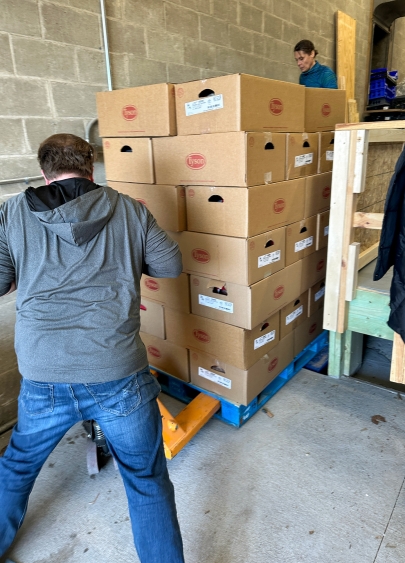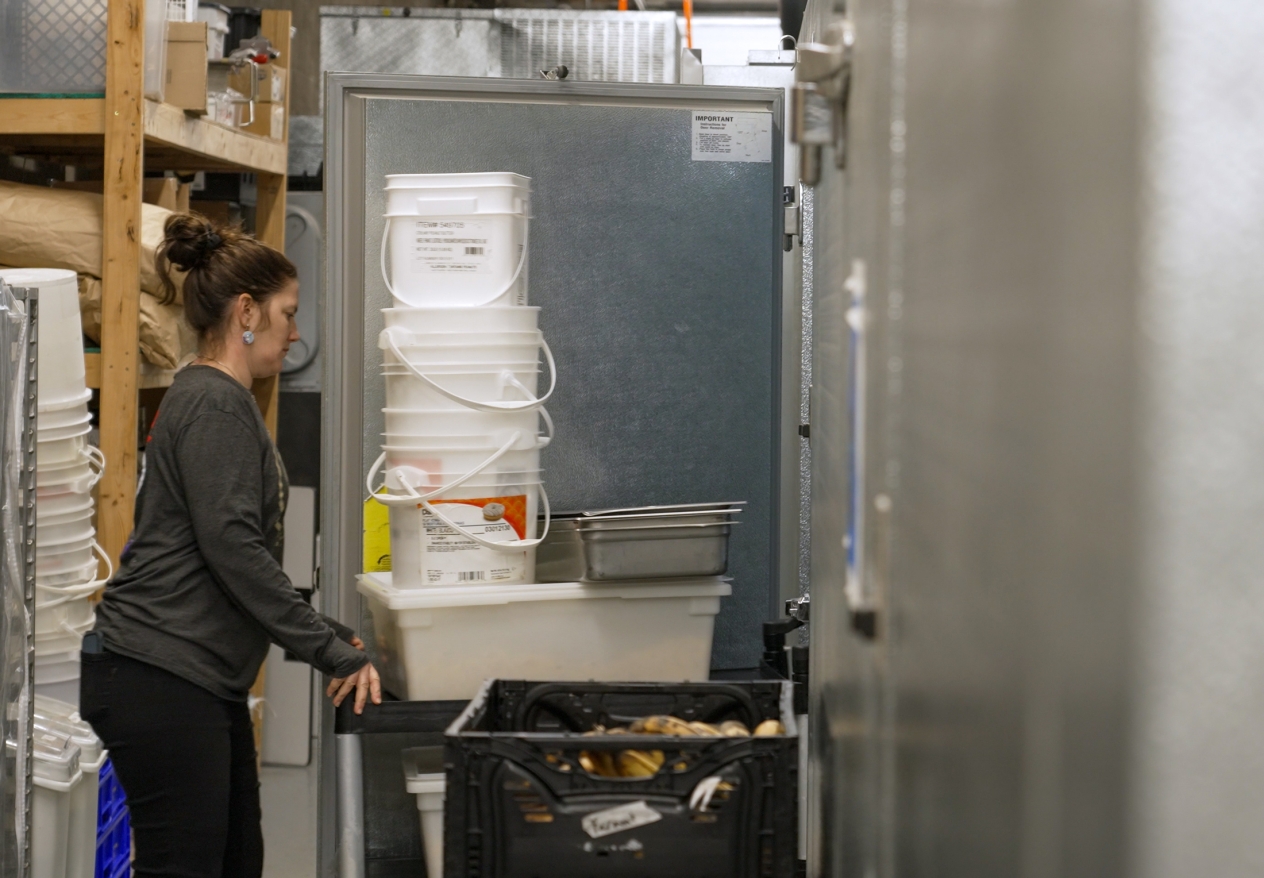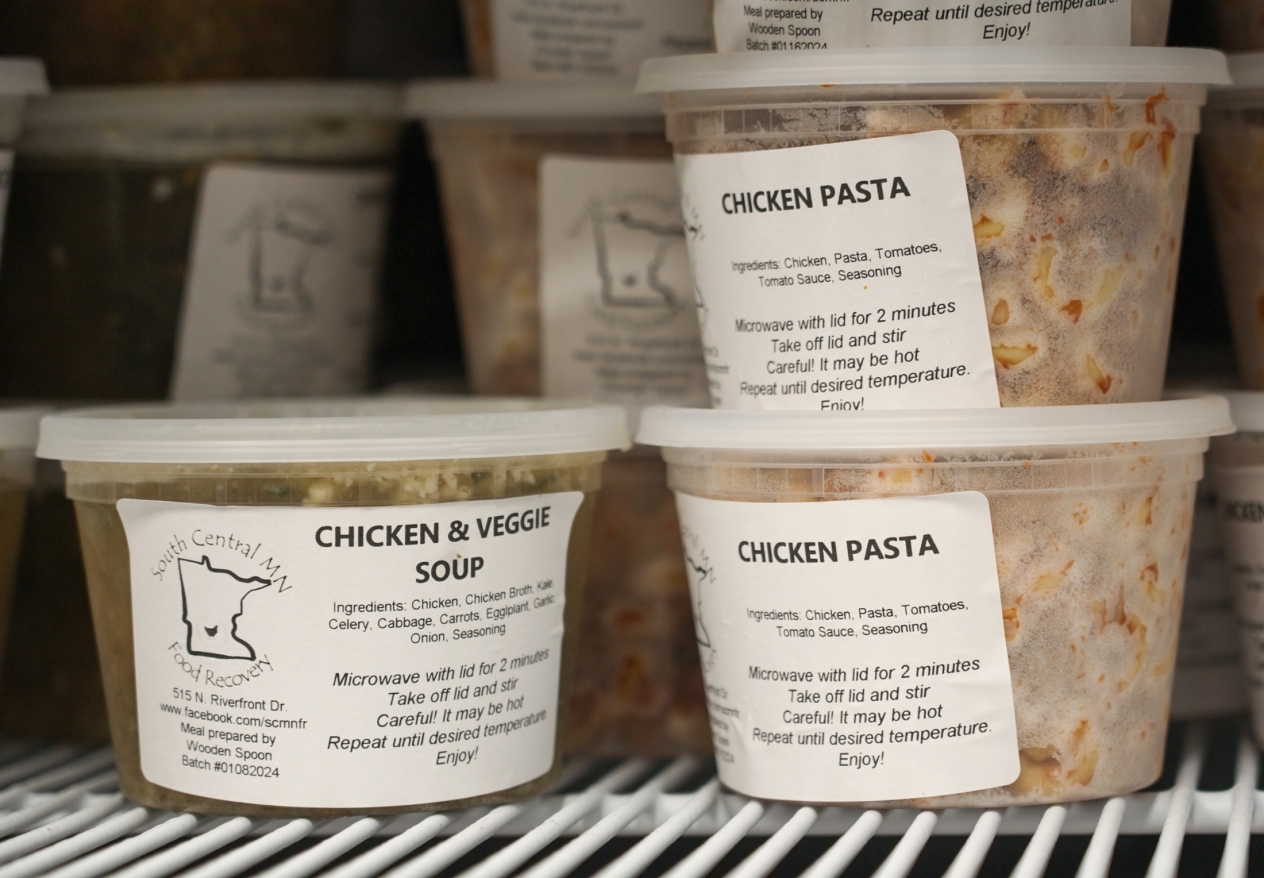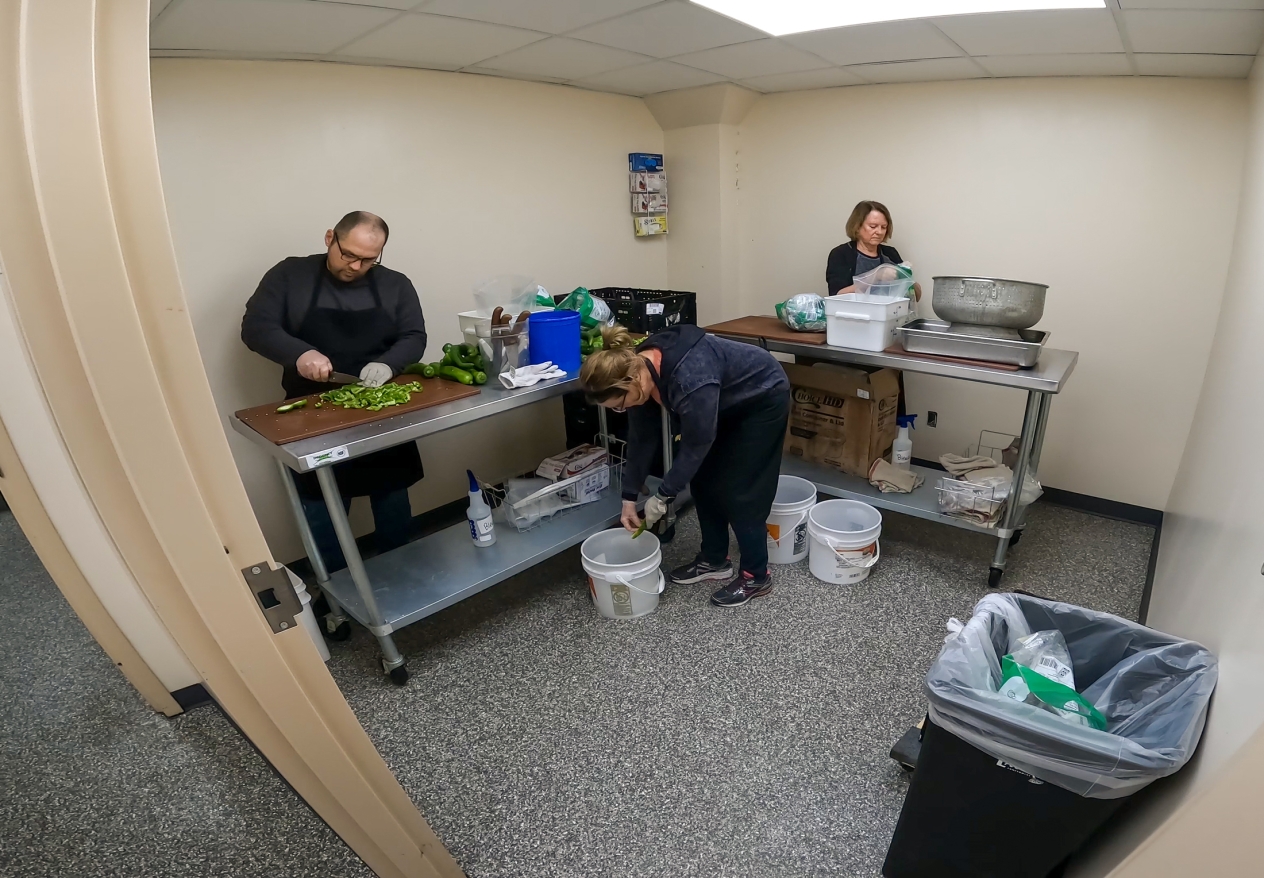Grants intended to prevent wasted food feed hungry Minnesotans, reduce greenhouse gases
Natasha Frost thought it was a once-in-a-lifetime event.

In 2019, the owner of the Wooden Spoon restaurant in Mankato agreed to cook three pallets — about two tons — of raw chicken after a local food shelf approached her. To do so, it took an entire three-day weekend and a team effort involving her chef, the food shelf, and a bunch of volunteers. She breathed a sigh of relief when she handed off the last of the chicken.
“Then two weeks later we got a call for the same thing,” she says.
It turned out that the local food shelf regularly fielded calls from truck drivers whose shipments to a nearby distribution center were getting rejected. One strawberry on an entire pallet might have mold on it. The order might be wrong. Expiration dates on the shipment might not match the distribution center’s system. Whatever the reason, the truck drivers had schedules to keep and trailers to unload, so the still-edible food had no other place to go but the closest landfill.
“Meanwhile, people were going hungry,” Frost says.
That made little sense to her or to others in the community, so with $150,000 in grants from the MPCA intended to prevent wasted food and encourage food rescue, she and dozens of partner organizations determined to keep that food out of landfills and on the plates of hungry Minnesotans.
Climate effects of wasted food
From an environmental standpoint, wasted food is often seen as problematic due to the greenhouse gases it emits in landfills. Methane, which organic materials release when they decompose, is about 25 times as potent as carbon dioxide when it comes to affecting climate change. As a result, many efforts to reduce climate change have focused on composting organic waste to reduce methane emissions.
While the MPCA does encourage organic waste recycling, it has in the last few years started to account for the full life cycle impacts of food grown and eaten in Minnesota, according to Annika Bergen, a senior state program administrator with the agency.
“Historically, we’ve talked about managing things at the end of life when they’re ready to be disposed of, but we know that only tackles a fraction of the impact that’s happening, and in most cases when it comes to materials or products, the biggest impact is during their manufacturing or production,” Bergen says.
Growing food requires — literally — tons of resources, everything from water and fertilizer to the diesel that fuels the tractor that harvests the crops. Using those resources has a big impact on the environment. According to Bergen, preventing one ton of food from going to waste — which also means preventing the resources that went into producing that food from going to waste — saves about 20 times more greenhouse gas emissions than composting that same amount of food.
Plenty of food needs saving, too. According to an MPCA study, food makes up 18% of everything that Minnesotans throw in the trash, and out of all the food that Minnesotans throw out, more than 45% is still edible. Six percent of that food is even unopened and unexpired.
The total greenhouse gas emissions from the 590,000 tons of wasted food in Minnesota every year — the equivalent of about 3.5 million tons of carbon dioxide — is about the same as the total annual carbon dioxide emissions from more than 766,000 cars in a year.
To counter this, the MPCA “shifted its focus upstream” in recent years, Bergen says. In 2019, the Legislature agreed to set aside $500,000 per year for the MPCA to distribute as grants to programs intended to prevent wasted food and expand food rescue in Minnesota.
That money can go toward everything from buying forklifts for moving around rescued food to hiring people to sort out five bad Granny Smiths from an entire pallet of apples. “The intent has been to allow broad eligibility as long as projects align with this upstream focus,” Bergen says.
That focus is exactly what Natasha Frost had in mind for the food rescue effort in Mankato.
Big fridges save food
After cooking the two tons of chicken, Frost quickly realized that Wooden Spoon couldn’t save everything that the distribution center was rejecting. The bakery and restaurant employs about eight to 10 people and shares its brick-faced two-story building in Mankato’s Old Town with other businesses, nonprofits, and even some apartments. Even if Wooden Spoon could afford the staff, it didn’t have anywhere to put the food coming off those trucks.
That changed with a $75,000 grant from the MPCA in 2020. Along with a $20,000 match from Wooden Spoon and a $5,000 match from the Mankato Area Foundation, the restaurant used the grant to buy a commercial cooler and freezer, then install the equipment on an elevated platform in a storage space next to the restaurant.
“We would not be here doing this without the MPCA’s investment,” Frost says. “It was a game changer.”

With the cooler and the freezer, Wooden Spoon and South Central Minnesota Food Recovery — the nonprofit that Frost founded to conduct the food rescue efforts — could hold on to rescued food for months or even years, which meant that Frost and a host of volunteers could start to create ready-made meals from the food. In a few rooms dedicated to the food rescue efforts on the building’s second floor, volunteers come in a couple times a week to chop vegetables, shred chicken, and dole out serving sizes in labeled containers.
Chicken and produce most commonly show up on the organization’s doorstep, but Frost says a variety of foods come off the trucks, everything from bananas and jalapeno peppers to salad mixes, chorizo, and even kombucha. The nonprofit has also started to take shipments from local farmers with excess crops, including one who donated 1,000 pounds of kale.
“There are some limitations when you’re solely using recovered food and you don’t know what’s coming,” Frost says. “The challenge is to develop healthy menus and meals based on what may be completely random. A lot of my energy is spent trying to figure out how to make a meal out of cabbage, kale, turnip greens, and chicken. We come up with a lot of soups.”

Those meals, labeled and packaged, then go into other freezers in the storage area from which other Mankato area nonprofits, food shelves, coalitions, and individuals can then distribute the food to people in need.
SkyAnne Walker is one of those individuals. She has distributed the prepared meals to Indigenous families and people in need in the Kasota area north of Mankato for three years now. Every week she gets an email from Frost with a list of what’s available in the freezers. Depending on her contacts’ needs, she then stops by the storage area to gather a few cratesful of prepared meals and fresh produce.
“I don’t think this need was being met” before the food rescue grant, Walker says. “This makes it really easy to be able to get the food where it needs to go.”
In addition to building out the physical infrastructure for the South Central Minnesota Food Recovery, in 2022 Frost also used a second $75,000 food waste grant from the MPCA, this time with a $25,000 match from Wooden Spoon, to expand the network of groups that distribute the food. Some of that grant money has been earmarked for replacing her weekly email with an app that includes real-time tracking of what the nonprofit has to distribute and notifications for that network of distributors.
“We want to do more with communications,” she says. “We’re now trying to figure out how to get the word out to more truckers so less food gets wasted.”
Putting a dent in the wasted food problem
In 2023 alone, South Central Minnesota Food Recovery recovered more than 53,000 pounds of food that would have otherwise headed to the dump. That equates to about 214 metric tons of avoided greenhouse gases, or about the same amount of emissions 47 cars emit over an entire year.
To Frost, those numbers are just as important as the nearly 24,000 meals that the nonprofit and its network of partners distributed to the community.
“We want to capture as much as we can and get that quality food right back out to those in need,” Frost says.
By managing surplus food and addressing food insecurity at once using prepared meals, South Central Minnesota Food Recovery is playing a critical role in sustainable food management, Bergen says.
“We’d like to see more projects that address food in this way,” she says.

Recipients of the more than $1 million in food rescue grants that the MPCA awarded in the first two rounds of the program in 2020 and 2021 were able to prevent 3.2 million pounds of food from being wasted, with a savings of 6,279 metric tons of greenhouse gases, or about as much as 1,400 cars emit in a year.
“It’s putting a dent in the process,” Bergen says. “There are good partnerships that are starting to come about as a part of this work.”
More grants for food rescue programs and preventing wasted food are on their way, too. In addition to the ongoing funds, the Legislature approved $3.5 million to fund even more food waste grants for the MPCA to award in 2024.
The MPCA has combined that with other funding sources for a total of $4.5 million in its current round of prevention of wasted food and food rescue grants; application deadline extended to May 10, 2024. For more information about this and other grants, visit www.pca.state.mn.us/grants.